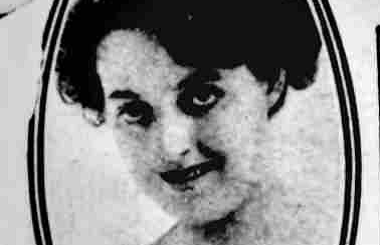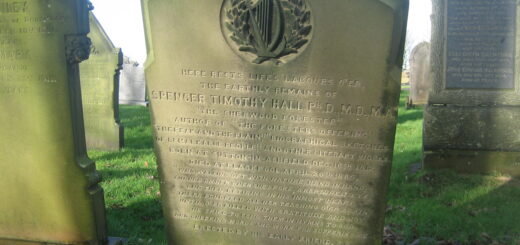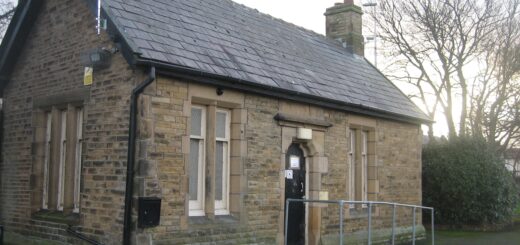Stanley Spencer’s Airship Flight from Blackpool October 21st 1902
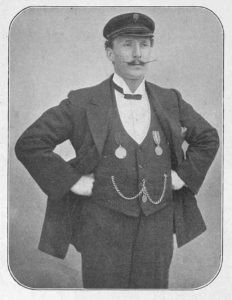
Introduction
When Stanley Spencer brought his airship to Blackpool on Saturday. October 3rd, 1902, the idea that the human being could conquer the air, like it could conquer the oceans, was still only a reality in the minds and the eyes of the mad inventors. To most ordinary folk, who spent their time and energies in the necessity of surviving from day to day, it was too much to comprehend, or they didn’t have the time to put aside to do so. It was inconceivable in the minds of most folk that one day they would be able to fly. The fact that there were those somewhat eccentric and considerably daring inventors, which included Stanley Spencer, who not only pursued the idea theoretically, but also demonstrated it in practice, brought a touch of celebrity status to their names and an air of excitement and wonderment to their activities. An airship with its mad or incredibly brave and talented aviator in the air at Blackpool was thus such an event not to be missed at the end of a busy and successful, summer season.
And it wasn’t just the wonderment of flight. Air ballooning had been around for a long time and there was always the thrill or the apprehension of what could (and often did) go wrong. There was so much that could happen at such a demonstration. It maybe that the reality of flight was to be demonstrated before the very eyes of a large crowd, but there was also the distinct possibility of disaster. The craft could burst into flames or drop to the ground from a great height killing anyone on board. It had happened before, quite recently in Paris, and it easily could happen again. The aviators might also fly away and never be seen again, taken away by the wind which they couldn’t control. Only a few years earlier, the three man expedition of Solomon Andre had disappeared during their attempt to reach the North Pole by balloon. They were never seen again, and only discovered 30 years later when three skeletons and equipment, and diaries of the expedition were found by chance by a sealing vessel on a remote island. Daring female balloonists, always good crowd pullers, especially with hardly any clothes on, had demonstrated both success and failure with those that lived and those that died. Indeed, such balloonists were often referred to as ‘balloonatics’, and now here was one in Blackpool. Stanley Spencer’s airship was a real event not a circus stunt, and Blackpool was the right choice for the event to take place. It was a sensation worthy of an energetic and forward thinking town and, as such, the Corporation of the town had put both its self-propagating money, its rate charges and its faith into it.
Having arrived on the Saturday, it was Stanley Spencer’s intention to fly his airship on the following Wednesday and, though he did get eventually get off the ground, it wasn’t until October 21st. It was the winds of breezy Blackpool that were to prove more of a challenge than expected.
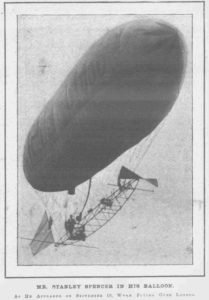
When the airship arrived in the town, it was a large piece of folded, silken material and a light wicker basket to take the pilot. There was an engine and its controls, a petrol tank, an 8 foot propeller, and ropes to keep it on the ground while being inflated. Stanley had arranged to put all this together to display it as a fully inflated reality, and he had arranged to give lectures from it at the Hippodrome circus. In 1900 the Hippodrome had been converted from the Empire theatre and a circus area was constructed which proved ideal for the display of the balloon. As the venue ran into financial difficulties and closed in September of that year, the balloon display must have been one of the last events at the circus in the building. Though the site is a now a car park, the building continued as the Hippodrome and then ABC theatres and latterly, the Syndicate nightclub.
Inside the spacious arena, it was inflated with air to reveal its full size, and it overlapped the circus perimeters at each end by a few feet and reached as high as the ceiling. The screw was made of pine and the silk fabric for the balloon was made in Manchester. It was 75 feet long and 20 feet in diameter, and it contained 20,000 cubic feet of pure hydrogen (when in flight) which cost £50 to fill, though inside the building it was filled with air. It was Stanley Spencer’s s determined intention to demonstrate the machine in flight, and he would not leave Blackpool until he had done just that. On the back of the enthusiasm for balloon flight, there was talk of a regular service of airships both inland and over the sea to the Isle of Man. Despite the success of the heavier than air machines, which eventually took over from the lighter than air machines in the drive for the success of flight, confidence had not crept into this idea as a commercial, passenger enterprise and even on September 30th 1919, with the enthusiasm and research and development of airship travel, it was still perceived as viable with dirigible air ships. The Zeppelins had demonstrated this and an option to secure 30 acres of land near Bispham was considered, to be used by the Great Northern Aerial Syndicate, to travel all parts of the country and Europe, as well as a local service using smaller airships. It was an idea that never came to fruition, of course.
Stanley Spencer
Stanley Spencer was from a family of aeronauts. His grandfather, Edward Spencer, made his first ascent in 1836 with Charles Green, his own father’s godfather who was ‘the first to introduce gas into a balloon, and the first to ascend with one so inflated.’ Stanley had been experimenting for years with his brothers and taken his subject seriously, believing that air travel was a foregone conclusion of the future.
Stanley and his brothers were manufacturers of air balloons with a workshop in North London, the place of their birth, but these machines depended upon the airwaves to move them along. It was the Spencers’ ambition to create a practical flying craft, one with an engine that could eventually carry passengers across the sky and, in this respect, it needed to be navigable by the pilot, not entirely dependent upon the wind, and so the word ‘dirigible’ began to be used for such a craft.
Stanley’s heritage was thus long and illustrious. His father had continued his own father’s tradition and Stanley and brothers had carried on from that. But to talk of air travel, as if it was a foregone conclusion was just for nutcases. And, of course, some of these nutcases were women, breaking the, perceived, male prerogative, as his wife, Mrs Rose Spencer, was able to fly the machine, and had even carried their 5 year old daughter Gladys, the first female passenger, around Crystal Palace earlier in the year. Rose was an accomplished airship aeronaut and she had also earlier successfully flown the balloon round the Crystal Palace polo ground, confidently sponsored by Mellin Foods at the time, and ‘exercised complete confidence and control.’ The millionaire Brazilian balloonist and Parisian resident, M Santos Dumont, whose first flight in an aeroplane brought controversy to the Wright brothers claim to be the first to fly, had promised the daughter of the President of the United States, Miss Alice Roosevelt, that she should be the first female aeronaut but, due to the damage to his balloon, Rose Spencer achieved that distinction before her. His airship, which would have been a rival to any aeronaut, had been mysteriously damaged beyond repair while exhibited at the Crystal Palace.
And among other women a host of other women there was Dolly Shepherd, Edith Cook, the inimitable Alma Beaumont and the tragicboth daring parachutists of the early kind. Edith Cook became the first woman in the world to fly a monoplane. She had applied for a position as a parachutist to the Spencers as a daring 20yr old, taking the name Spencer in one of her assumed names. She was killed as a result of a fall while descending by parachute in July 1910, when she took the place of Dolly Shepherd who was in hospital with spinal injuries, and whose parachute descent had earlier gone wrong. In May of 1902, Edith Brooks was killed in a failed descent above the Wednesday football ground in Sheffield, falling to her death in Hillsborough Park. There was some confusion as to who the body belonged to but it was later revealed to be that of Edith and not that of her sister Maude, the more famous of the two. Questions were asked in Parliament about the wisdom and safety of inexpert parachuting and the management of such people and events was carefully impugned. But why shouldn’t they take the risk if they should thus so dare and earn good money and celebrity for doing so. They had every right to be a nutcase as any man. Some time later, in August 1928, and continuing the list of women who dared, or were convinced to dare to parachute, June Williams descended in a record breaking, low fall of only 150 feet over Stanley Park at Blackpool.
Despite the efforts of the Spencers and others, ad despite there being a balloon corps of the British army during the Boer War, Britain would always lag behind the Continent in using balloons for the like of weather forecasting or, from a height, observing at what depth a submarine could be viewed. The progression of flight was to be hampered not only by sexism through the decades but also by privilege, which precluded those without sufficient status from belonging to the newly formed Aero Club. Genius aviator or not it didn’t matter. On September 24th 1901 Stanley himself, had conducted a group of three passengers, namely Frank Hedges Butler, his daughter, Vera Butler and CS Rolls, keen motorists on a flight in his balloon. The two male passengers were founder members of the Automobile Club, and Charles Rolls was the first half of the Rolls Royce name. During the flight, while they were approaching Sidcup, it was suggested, it seems by Vera, the only woman, that they should form an Aero Club and all agreed. As such the Aero Club could be seen as an offspring of the Automobile Club. Frank Hedges Butler was one of the first people in England to own a motor car. The Aero Club itself, as the Royal Aero Club from 1910, naturally became the ‘godfather’ of the Royal Flying Corps which later spawned the RAF. But it was a gentleman’s club and to which as such, only those of status could belong, and Stanley was only a manufacturer and inventor and accomplished navigator. He didn’t have the social status nor the funds so he couldn’t become a member. The Club itself held its inaugural flight from Stamford Bridge (London) on November 15th. Ironically of the three aeronauts on this flight, there was only Frank Butler who was an eligible member of the Club since the other two, Stanley Spencer, who was only a brilliant pioneer and whose balloon, The City of York, it was, and Miss Vera Butler who was only a woman did not have the required qualifications. CS Rolls would have flown but gave up his spot for Miss Butler, not out of gallantry, but because the weight calculations in the changed climatic conditions of the day favoured the lighter person.

Dedicated inventors and experimenters like Stanley Spencer, were enthusiastic, skilled and determined. Stanley was confident and stoically brave or foolhardy, evoking that classic phlegmatic demeanour of the quintessential Englishman, at least in public anyway. Though he had demonstrated both ballooning and parachuting all over the world, his life was ever in danger from incidents and accidents that could have taken him away from the world, higher and further than any balloon or airship, or aeroplane or even modern space rocket could have taken him. He could have died on more than just a single occasion. His airship trial in the October of 1902 at Blackpool was his first trial after his successful London demonstration which he had made some weeks earlier. He was fully confident in the machine and equally with himself, and now he was to test how his contraption would deal with the sterner test of breezy Blackpool, and which would constitute a further test to the efficacy of his machine.
Such a man and such an event were the lifeblood of the ambitions and the reputation of Blackpool’s promotional aspirations.
LECTURE
When the reporter from the Lancashire Daily Post arrived at the Hippodrome, he found a man, ‘dressed in a navy blue jacket’ and looking ‘every inch a navigator’, and stood among the pulleys and the ropes of his new airship which was inflated with air and which rose as high as the dome, and below which was suspended the cradle in which Mr Spencer stood when he conducted his successful flight over the London’ some weeks previously. He was a ‘closely knit man, of middle height with a moustache.’
The airship was fully inflated and rigged up and the ‘framework, car and balloon appears to almost fill the great roof of the building, and is much larger than the measurements on paper…’ The length of the bamboo frames reached over the circus sides a little way. ‘Stanley Spencer climbs into the car by means of a ricketty ladder on which he claims he felt far less safe than being in the air in the balloon. The envelope of the canvas is silk so, if one blows, the other should act as a parachute.’ Stanley perhaps had a little too much confidence, bordering on blind faith, in his own ability and the reliability of his equipment but, in the end it wasn’t the balloon or his own incompetence that killed him, it was just a little microbe.
From the vantage point of his platform in the bamboo framework of the car he explained the mechanism of the machine. The motor is manipulated by means of cords attached to a clutch between the propellor and the motor. Another cord is attached to the timing gear of the motor which can regulate speed. The motor itself can be switched on or off by means of an ‘electrical communication between the motor and the car’. In dead calm conditions, the ship can reach 15mph. The tractor is 10 foot in diameter and created from a design by Hiram Maxim (a man no stranger to invention, including the machine gun and of course, with a different, more peaceful invention, at Blackpool pleasure beach). His machine gun invention, he claimed, would end all war beuase of its highly destructive nature (a precursor of the idea of nuclear weaponry). He died in the early part of WW1, with his claims, genuine and hopeful as they may have been, in tatters.
Stanley Spencer the lecturer, had designed the airbag to cope with potential breaches of the fabric and the consequent loss of the hydrogen. It was what he called the ‘double parachute principle’. If all failed then he would parachute down, and he was no stranger to parachuting and had demonstrated the skills on several occasions previously. The total weight that the balloon had to lift was 660 pounds which included the machine itself, his own 9st 12lb with 50-60lbs of sand ballast and at least two gallons of petrol.
He is at present, he tells everyone who has paid the entrance fee and who is eagerly listening, designing a new engine to carry a fifty horsepower engine with the capability of carrying at least six passengers. With experimental flying taking part more enthusiastically in other countries of Europe, Mr Spencer was proud to claim that his machine was entirely British. In his earlier flight over London, he had two Union Jacks on the front of his machine. He would come back to Blackpool with this machine and conduct regular flights from the town to the Isle of Man, and for this purpose he would conduct experiments over the sea from Blackpool. He had brought his own hydrogen making plant and this would be fixed up at the gasworks so he can make his ascent from there.
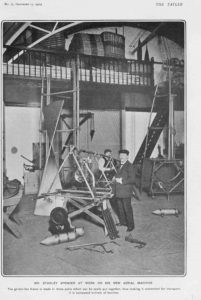
He was keen to tell of his experiences to the reporter as much as the reporter was keen to listen, and keen to publish his report. He had ballooned all over the world, financing it by a paying audience or the generous fee of an interested patron. In Hong Kong he had had a miraculously escape when he fell 600 feet in his balloon. When the balloon rose into the air, it was seen to be ripped as one of the local helpers had misunderstood orders which had caused a little damage. However, Stanley decided to continue since the consequent hole was safely near the base of the balloon. But at 600 feet the balloon suddenly collapsed and came tumbling down like a stone. He was unable to release his parachute but by good fortune crashed into the side of the cliff at Bay View. These cliffs, not being vertical but at a sharp angle down to the sea, broke the fall of the balloon and it then ‘merely’ slid down the slope to stop when it became entangled in a tree. His leg was broken in two. He was rescued and soon recovered, proud of his ‘grand recuperative powers’.
In 1890 he was in South America with Alma Beaumont and her manager. He nearly drowned twice and all three lost all their money, having to rely on handouts to get home. Apart from William Woodside, the former champion cyclist, who had contracted yellow fever from which he died and was buried there.
On one occasion in India, as he was about to step into his balloon cradle, the Nawab Nisan of Moorshedabab, for whom he was demonstrating, suddenly forbade him to fly as, so it is reported, he might break his neck and if so, he would not be able to show him his harem. Stanley however was a quiet, unassuming man, so we understand, and a man whose energies were more directed to his experiments in conquering the airwaves. However, whether he indulged in the concept of historical, male dominance, or whether the Nawab was insulted if he hadn’t, is not reported.
After a successful tour of India, from which he had made plenty of money, and which was possibly a motive for his ambition (though nerves of steel and an original idea like any entrepreneur were needed), he moved on to China where he learnt there had been no balloon ascents. He arranged a lift-off spot in the yard of the home of a mandarin and a great crowd assembled at the appointed time. He conducted a successful flight and chose to come down in a lake since he feared the enthusiasm of the crowds. He was picked up by a boat full of women who looked upon him as a curiosity. The following flight attracted an even larger crowd and, as he rose above the town, the crowds rushed hither and thither, across house tops, hedges and fields in over-excitement and there were even reports of several deaths in the crushes. There were those so intrigued by the fact that the human being could fly, which resulted in several incidences of people throwing themselves off rooftops to replicate the idea. These facts led to the cancellation of a third flight as the locals had begun calling him the ‘White Devil’ and he was given 24hrs to quit the town. When he came to leave, he was escorted away by 20 excited Chinese soldiers.
On another trip he had been able to reach a height of 27,500 feet, a height at which the air was rarefied and it was a kind of ‘champagne experience’ but the cold was intense and it was good to descend to the warmer air. In an earlier flight 1898, and accompanied by Dr Benson, he had first achieved a record height of 25, 000 feet over the Crystal Palace when they both had to take in oxygen, compressed in a cylinder which they had thoughtfully taken with them strapped to the car.
Ballooning was not only subject to the hazards of the atmosphere, but also to other dangers. In Settle, Yorkshire, two Volunteers were charged with ‘having unlawfully discharged their rifles on the highway’, on Saturday Sep 20th 1902, when aiming at a balloon in flight. Though it was hard to imagine a Volunteer mistaking an airship for a toy balloon, (as was the meagre excuse of the defendants) there might, perhaps be the explanation that there was a plentiful supply of pubs en route from the fairground at which they had been competing. The balloon was carrying Dr Barton and Monsieur Guadron (a French balloonist and parachutist) from the Botanical Gardens in Manchester to a destination in Durham. Dr Barton was constructing a dirigible airship in Manchester for the War Office. They heard the shots and noticed at least one bullet fly through the rigging, but no damage was done. It was a military experience, one of coming under fire, though one of equally dangerous, friendly fire. The Volunteers were fined a 1s (5p) each with 8s (40p) costs.
And there was the potential damage to property incurred on landing, a hazard of all the early, since there were no airports or even landing strips. The pilots of these aircraft, would find a suitable field to land in, certainly in the case of an emergency, and it was then that they had to hope that the landowner was of a friendly disposition. Stanley Spencer had experienced both. In December 1905, at Lancaster County Court, he was fined £5.00 for damage done to hedges the previous Easter. So, in the drive to create the phenomenon of flight, any innovator could be nobody’s friend, just an eccentric and had to pay for any mistakes that might be made due to misfortune. But, on other occasions, like when he landed at the end of his Blackpool flight, he was a friend of great celebrity status.
For Dr Barton, his work was entirely self-financed and success was denied him not only by the lack of funds, but those who would carelessly take a pot shot at him. Success depends upon luck and circumstance sometimes as much as the confident genius of skill in innovation. Due to accidents in his workshops in London, his prototype airship did not fly again and, without enough funds to continue development, he resorted to his medical practice. Meanwhile the government sponsored German airships on the Continent were allowed to develop, resulting in the sophisticated Zeppelins and which bombed London in 1915. It was continental Europe where research was taken more seriously in an official capacity.
And so in Blackpool, a town which at the time was in the forefront of anything that would attract a crowd and that could be given the best of publicity, when Stanley Spencer and his airship arrived, it was a weekend of high interest and excitement. His lectures from the car of his inflated machine, in the financially struggling Hippodrome circus, were enthusiastically received, and were much talked about throughout the district and well beyond the town itself. And when he announced that he would be back in Blackpool with his larger, 50hp machine which was under construction, he received even more enthusiastic applause.
He might have been aware that a heavier than air flying machine was being developed in America by two other brothers who, the year following his Blackpool flight, would show the way forward for aerial flight for the foreseeable future. But dirigible, lighter than air craft weren’t killed off completely as the testimony of the German Zeppelins would demonstrate. As late as 1936 the giant German airship, the Hindenburg was flying over Blackpool, past the Tower at 3.15 am. It had only been allowed to fly over the country because of adverse weather conditions, but the nerves of the people were still on edge even then, as suspicions ran deep, and there was a blanket ban on photography from such machines, even though smaller, much more efficient cameras would make this an impossible task to police. It was observed passing above the tower at a great height, revealed by its cabin lights and searchlight in the dark of the night. The ill-fated R101 when it flew over the town seven years earlier in 1929 at 4am, created a good spectacle for those who were awake to see it. It was on its way to Dublin which it reached at 7pm.
As far as heavier than air machines were concerned, there were several aeronauts who would want to claim to be the first man to fly one, but it was eventually the bicycle enthusiast brothers that would claim the prize from their dogged seasons of experiments on Kittyhawk beach in the USA. Until that day arrived in 1903, there were those who pursued the idea of a dirigible, or navigable, lighter than air balloon or airship. The issue to resolve was navigation, and to make a lighter than air craft controllable, and Stanley Spencer had put his effort into proving it was possible with all his confidence. And he was in Blackpool to demonstrate it.
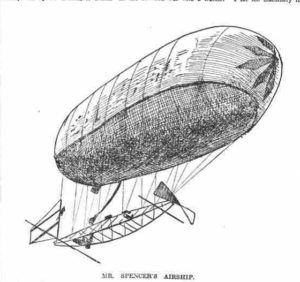

By the end of September 1902, when the news was available that Stanley Spencer’s proposed flight away from the capital would be at Blackpool, there was speculation as to what format it would take. It was first thought that he would make a trip over the sea and be towed out initially by steamer before returning, under his own power, to the land to perform ’evolutions’, as his short, flying manoeuvres were called. Other ideas were that he would make a circuit of the Tower, and then pass over several Lancashire towns before his final destination of Manchester. The event created a great deal of excitement due to his recent, successful and record-breaking flight from Crystal Palace to a point near Harrow, a distance of 30 miles, the furthest distance achieved by any aeronaut to date. Since Mr Spencer was being paid for the feat, he bravely vowed that he would not leave the town until he had accomplished it.
Mr Stanley’s air balloon arrived in Blackpool on Saturday October 4th. It was in sections and was transferred to the Hippodrome where it was to be inflated with air for demonstration purposes. The plan was to make an ascent the next Wednesday from near the town gasworks and it was hoped that the weather would prove favourable.
The musical festival, with over 2,000 competitors, had just concluded in the town and it was such a success that it was decided to continue it as an annual event. There had also been a confetti carnival at the weekend, and a regatta and aquatic sports earlier. So the excitement of an air ship display continued the thrills that Blackpool had to offer in a late autumn extension of the summer season.
On October 9th after having been displayed at the Hippodrome where it had been inspected by over 10,000 people, the airship was removed to the gasworks, where it would be inflated with the expectation of a flight in the afternoon. Stanley had brought with him his own hydrogen gas making plant, where he used sulphuric acid and iron filings to produce the gas, and this would be fixed up at the gasworks which were situated on Rigby Road where the plant supplied the town with that commodity and which, with its tall, tall, chimneys at one time of wishful thinking, was mistaken in the near distance for the Tower, by the tired minds of a group of eager cyclists at the end of their gruelling journey from Yorkshire.
However, today there would be disappointment for everyone for Mr Spencer claimed that, with the direction of the wind, he would have been carried out to sea and would have had to descend into the sea had anything gone wrong. But he would remain at Blackpool until the conditions were favourable.
On Monday the 13th he made a short, ‘captive’ flight at night in the region of the gasworks. He had not tried this venture in the dark before. The ship was inflated but held captive by the ropes which were controlled by several men upon the ground.
The following Wednesday, October 15th, saw another abortive attempt at a flight when, after the ship had been filled at the gasworks, the wind at 25mph was considered too strong to make the flight.
By now, there was much scepticism about the airship when, it seemed, the pilot could never take off, and he came under quite some criticism from an increasingly impatient public. Since early October Blackpool has been anticipating the ascent but the weather had always been against it. Large crowds had gathered around the gasworks the previous Saturday, but no ascent was possible. However, in the early evening Mr Spencer decided to make an attempt at ascent despite the ship being only partly filled. He first made a short, solo flight then returned to pick up the mayor and mayoress and a ‘Miss Howarth’, presumably the the daughter of the mayor, Alderman Howarth. It was, however, another captive flight as a party of men once more steered the balloon on ropes from the ground. As far as a public demonstration went it was partly successful, but since it was dark, there was not much for the guests or onlookers to see.
The Lift Off
When the Tuesday of Oct 21st 1902 arrived, there was still a bit of a breeze, which was not unusual for Blackpool, but Stanley had decided that it was to be the day for take-off.
He had arranged to set off when the signal of the white ensign flying in place of the Union Jack, from the top of the Tower, was given. This was raised at 1pm and by 2pm a crowd of about 2,000 had already assembled at the gasworks. It seemed as if the whole of Blackpool had come out to see him. He was now about to prove his critics wrong. And he kind of did…and didn’t, as history would eventually favour the heavier than air machines first lifting off the ground on the east coast of the USA the following year.
The balloon of the ship had been kept inflated after the abortive attempt of Saturday, and had been retained in between the retort house and the purifying house, and it needed only a little top-up of hydrogen before being fully expanded. The rain fell, but only lightly and it did not affect the proceedings. The ship however wasn’t ready for a long time and the crowd had increased considerably. The plan of circling Blackpool was given up in favour of a direct line for Preston and beyond, due to the strong wind. Wherever he landed, he would telegraph the mayor (who was actually away on a mayoral banquet an the Mansion House in London). About forty men had steered the airship out by the ropes to some open ground close by to facilitate the lift-off, and it was a time when many photographs were taken.
The wind whipped round the buildings and hit the ship broadside, moving it and making it strain on the holding ropes, as it was weighted down with sand bags. It was truly a suicidal enterprise to attempt to fly such a thing in such conditions, but Stanley Spencer was undaunted, and his wife, Rose, showed no signs of anxiety as she calmly chatted, as one who was the first woman to have flown such a machine, with Aldermen John Bickerstaffe and Grime and Coucillor Collins, Mr Chow and Dr Molloy, among the official representation in the large crowd that had assembled.
Stanley Spencer coolly entered the car of the ship like a man whose destiny it was to successfully conquer the airways. Before ascending, he kissed his wife goodbye, waved his cap in the air to the crowd which was now an estimated 12-14,000, and he was away, the first few manoeuvres being somewhat jumpy in coming to terms with the gusting wind rushing out from behind the tall buildings. He was thrilled at seeing the thousands of faces looking up from below.
The lift off by his own account was not so smooth and he was concerned that when the ship hit the ground which it did a couple of times before eventually rising completely, the bricks and sharp objects scattered cross the ground of the yard, might render some damage. As the ship rose further into the air, the crowd cheered and raised their caps as the craft was buffeted a little by the veering wind which was now blowing inland from the north west and which would make the journey in a south westerly direction much easier. However the difficulties were not yet over. On setting off he narrowly missed the corrugated roof of a building and soon had to drop a couple of sandbags to lose some weight, and then he even discarded the grappling iron which was there to facilitate the descent, in order to achieve the height necessary to avoid the electric tramcar on Central Drive. His trail ropes nevertheless caught the overhead wires of the tramway, pulling them off and knocking over an onlooker who had been stood on a wall to get a good view.
As he was on his way, Mrs Spencer sent a telegram to the mayor in London to announce the flight of the airship.
Stanley at first began to drift over the very new Revoe Board School, devoid of pupils because of the time of day, and most of who would have been watching, anyway. Just like a sailing ship, he had to deal with the wind, but with a much lighter and far less substantial craft, and the sky was a vast ocean of the unknown into which he was taking his machine. The 20mph wind proved too strong for his motor to ride into and which had influenced his cancellation of a trip around the Tower, and he decided to run with the wind and turn generally south westwards, the intended, and eventual course of his journey.
But he was able to make a few skilful evolutions before setting of inland and, in his own words, ’Let me tell you what I saw. During my evolutions I must say I admired Blackpool immensely. It is a lovely looking place from aloft – the Tower, Wheel, great buildings, and the piers piercing the sand stretches. The tide was out, and as far as I could see was one large white surf line. It looked very beautiful and imposing, but at the same time very threatening’. His route took him over Marton Moss to the right of Marton Mere, the ‘Black Pool’ that had largely given the town its name, and then through the Fylde countryside past the destructor at St Annes, and the the large expanse of the Lytham Hall estate, crossing the railway line at Moss Side station and then on to the pretty village of Wrea Green, keeping Kirkham, still with some official control over Blackpool, to his left and approaching the Ribble, keeping to the north bank until, first crossing about Freckleton, made two complete circles over the river, demonstrating his control of the machine, and then he continued his journey. He would have landed in Preston itself had he not (jokingly afterwards) claimed that he didn’t want the thousands of folk following his progress as he was about 500 feet in the air, greeting him when he landed and running off with bits of his machine for souvenirs, as had happened to him before when he came down in his balloon in the Punjab where he was generally well known in India as he had made many ascents there.
All the way to Preston and eventually to Leyland there must have been plenty of strained necks as observers rushed out into the streets and fields to observe this strange phenomenon as much as I remember working at Norcross an we all came out of the offices to watch the Concorde on it first flight. Had the airways at last become navigable? Could a balloon or airship be truly dirigible? Whatever was possible, and which the future would determine one way or other, to prove some right and others wrong, this was certainly a remarkable occasion.
By Leyland, Stanley had decided it was time to land. His height had varied between 500 and 1200 feet and he chose Leyland to land because he had been there before during the festivals when had both ballooned and parachuted. He was looking for an extensive field to land in, the privilege, or the necessity of the early flyers at that time, and in the years to come before the concept of purpose built airstrips or municipal airports had been conceived and constructed. He could see people running on the ground below him. He pumped air into the fabric in order to drive out the hydrogen and began his descent. Despite the trailing ropes catching on a tree, causing slight damage, the descent was going well until, crossing the Lancashire and Yorkshire railway line from Preston to Liverpool, the trailing ropes also dragged along the line of Midge Hall station with an express train bearing speedily down upon them. Stanley Spencer called out to the station master to stop the train but the call came back to, ‘Stop your ship! That’s the easiest!’ a call which would presage the rivalry between road, rail and air as commercial air travel, the new kid on the block began to take off in the inter war years some decades later. He narrowly missed the train , the trail ropes only just passing over the tops of the carriages. The passengers must have had been quite startled. He dropped faster after that and the anchor caught on a tree. Men were hurriedly running across the field towards the ship now, and they were able to release the car which had partly lodged in the branches of the tree.
He had landed at 4.25pm. He was unscratched and the only damage to the equipment was a few broken wire stays. Asking where he was, he was told that he was on the farm of the executors of Henry Dandy at Ulnes Walton. Mr J E Pickles who was among the men who had come to assist, offered to take the ship back to Blackpool the following day. He had been among the many who had travelled to Blackpool in order to see the airship take off and had been one of the many who had also been disappointed when it hadn’t done so at the beginning. He and his wife had spent three days waiting and in that time had gone to the Hippodrome to view the ship and listen to the lecture. This was a remarkably fortunate turn of events for him.
When the reporter from the Lancashire Daily Post, in touch by telephone, wrote of the progress of Stanley Spencer’s flight in ‘that wonderful invention’, found that he had landed somewhere near Leyland, he set off to look for him and he entitled his report, ‘in Search of Stanley’. The telephone had rung at 3.40pm to say that Stanley had set off from Blackpool and at that moment he had jumped in a hansom cab and raced off at 12mph with a fast horse towards Chorley from where the report of his landing had come. At Farington, he was told that he had come down at Lostock Hall, or maybe, Midge Hall, his informers weren’t quite sure. At the Black Bull at Ulnes Walton, he was advised to get to Midge Hall since Stanley Spencer had been sending telegrams from the post office there. But, just then, informed by a farmer’s son, he got to know the exact location when he was told that Mr Pickles of the tomato farm had taken a lorry and gone to fetch him from a field in Dandy’s farm about a mile away.
By now it was pitch dark, but eventually, down the lane he saw a light and then heard the rumble of the lorry, and there resulted a classic meeting of typical English phlegm as Stanley, smoking a cigar and his spiked moustache twitching slightly as he spoke, smartly dressed and without a care in the world, walked calmly alongside the lorry, accompanied by a James Longton who had raced by bike to help with the landing.
Offered a trip back to Blackpool, Stanley was only too pleased to accept the lift to the railway station in the hansom, but meanwhile they stopped off at the house of Mr Pickles, the lorry owner, and had tea. An elderly person in the group had spoken wisely to the children present, ‘remember you will be able to tell your children of this great event, that this record breaking airship came down in Dandy’s field’..but then.. the generations did forget ….. eventually. It’s not unusual, as time moves on and only the present is relevant.
Stanley Spencer left Preston railway station at 7.55pm and arrived at Talbot Road station in Blackpool at 8.30pm, where a proud and relieved wife kissed him. Blackpool representatives were also there to meet him. The Mayor, Ald Howarth, was not present, he was no doubt still tucking in to the Lord mayors’ banquet in London and he would telegram him of his success. In the excitement of his success, and the pride of his invincibility, Stanley Spencer spoke enthusiastically of Blackpool and thought that the Tower would be a great landmark when town to town services would start, as they most definitely would at some time soon. Ironically it became a navigation landmark for enemy bombers in a War, several decades later, of which Stanley could have no prescient knowledge, and would not live long enough to experience.
The airship returned by road and arrived in Blackpool at 5am. It was Mr Spencer’s intention to put the machine on display once more after what he described as an entirely successful and satisfactory flight having shown that his vessel, light as it was, could deal with the strong winds that Blackpool had provided. He regretted the deaths of his ‘colleagues in Paris’ who had recently died due to not adhering to the principle of keeping everything ten times stronger than it needed to be. In Paris, Baron de Bradsky and his mechanic, Monsieur Morin were killed when their ship lost its balance and came crashing to the earth killing them both, inciting someone in the crowd to shout out, ‘What can you expect if you set off on the 13th of the month from a shed which last saw two previous aeronauts who left never saw again!’ Flying was a dangerous game, death often intervened before success could be achieved. It all added to the spice of the event at Blackpool.
Though Stanley Spencer regarded his flight as a great success, there were his critics who would claim that he was helped on by a 45mph tail wind. The airship could only travel a few feet into the wind before it became unstable. He was aware of the problems that he had to deal with but, for people like him, failure was only a pause on the way to success. He intended to build a stronger craft which could easily cope with the ‘beautiful breezes of Blackpool’.
The military had already become very interested (as they had done later on with the Wright Brothers’ patent) in the idea of airships, and had developed their own version. In taking his ship over London he had demonstrated its military potential by throwing things overboard, as imitations of grenades. In 1901 Stanley himself had been in charge of the ‘Messrs Hudson’s huge war balloons.’ Percival Spencer, Stanley’s brother, who had also flown all over the world and in the presence of the likes of the Csar and the Mikado, and still at work in his Highbury factory in September 1907, had offered his designs to the military, some of which he considered superior to the military designs in place at the time. The patent had run out and not been renewed. Sometimes though, the airships and balloons were more a danger to the fliers than to an enemy when considering their use in the military. There were those with faith in the machines and there were equally those with scepticism.
The cost of the visit of Mr Stanley Spencer and his airship to Blackpool amounted to £444. 8s 5d, (£444.42p approx.), but the receipts from the event only amounted to £201 17s 5d, (£201.87p approx.). The cost of the coronation (of Edward VII in August) and the airship ascent combined amounted to £2,500, which represented 1½d on the rates (approximately an eighth of 5p).
Bankruptcy
On 12th April 1904, Stanley Edward Spencer attended the London Bankruptcy Court. His income had always derived from fees for making ascents in his balloons and airships, and he had entered into an agreement with Mellin’s Food Ltd the previous April to make 25 flights in his airship with their advert displayed on the sides. He received £250.00 cash and costs of £1,250.00 for the contract. However the last payment of £500 hadn’t been received from Mellins who claimed he had to complete the contract first. It was the costs of litigation in this affair that had taken all his money and he still owed them £134.00 and which they wanted back.
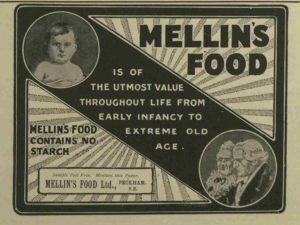
DEATH
On January 27th 1906, news was received in London of the death of Stanley Spencer. He was on his way home from India on the City of Benares and was disembarked at Malta due to illness, where he later died of Typhoid fever. He was buried on the island on the 26th January.
And his poor state of affairs continued after his death. On May 17 1907, a correspondent in the Islington Gazette appealed for votes in favour of sponsoring his daughter, Gladys, to the London Orphan Asylum at Watford. Mrs Rose Spencer was an Islington girl and her parents were strong members of that community, socially and religiously, and her mother often wrote poems to the local press. Her father was the auctioneer and parish broker. Mrs Rose Spencer, now living at ‘Balmoral’, St Simon’s Road, Southsea, (the place where Gladys was baptised, though with her parents address in Highbury, London) and her three children were now in ‘straitened’ circumstances. There were already several gentlemen recommending the case, and the plea was to the hearts of anyone else concerned. The plea seemed to have worked since there is a Gladys Rose Spencer on the 1911 census at the Watford school.
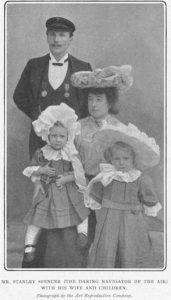
The newspaper article from the Sketch of October 1903 claims Stanley and his wife to have ‘four, bright-eyed children and ‘on a rainy day, all the children are to be found in the balloon house at Highbury playing with toy balloons.’ Though ’all the children’ might refer to any children of friends or family, since he lived next door to his brother, Percival who also had children, so the ‘children’ referred to could well have been those of the two families. The Wikipedia contributor, claims only a single daughter (and a child, sadly subject to an infant death). The 1901 census has only the single child, Gladys.
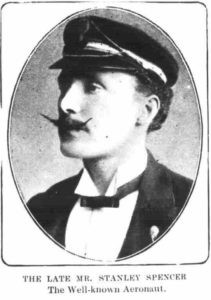
Bibliography
Most of the story has been gleaned from contemporary newspaper reports. (British Library newspapers via findmypast)
The Wright Brothers by David McCullough published by Simon and Schuster
Website referred to;
http://www.ballooninghistory.com/whoswho/who’swho-s2.html
https://paperspast.natlib.govt.nz/newspapers/OW19060404.2.42
http://edition.cnn.com/2003/TECH/ptech/12/10/brazil.santosdumont.reut/
http://www.arthurlloyd.co.uk/BlackpoolTheatres/HippodromeBlackpool.htm
https://www.gracesguide.co.uk/Frank_Hedges_Butler
http://www.suffolkaviationheritage.org.uk/edithcook.htm
https://en.wikipedia.org/wiki/Stanley_Spencer_(aeronaut)
Pictures
Newspaper image © The British Library Board. All rights reserved. With thanks to The British Newspaper Archive (www.britishnewspaperarchive.co.uk).
Stanley Spencer from the Illustrated Sporting and Dramatic News. October 1903
Stanley Spencer in his workshop with propeller The Tatler December 17 1902
Stanley Spencer family The Sketch October 14 1903
The late Stanley Spencer The Leeds and Yorkshire Mercury January 1906
Mr Spencer’s airship The Lancashire Daily Post October 1902
Stanley and Mrs Spencer in the workshop The Penny Illustrated Paper September 1902
Stanley Spencer and the Aero Club The Illustrated London News October 1926


